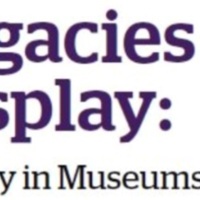
National Museum Afroperuano
The National Museum Afroperuano (or National Museum of Afro-Peruvian History) opened in 2009. Housed in the 'House of Thirteen Coins', in Lima, the museum is dedicated to acquiring, preserving and interpreting objects relating to African history in Peru.
The exhibitions begin by examining the arrival of Africans in Peru, via the Portuguese slave trade. The interpretation explores the process of enslavement and transportation alongside the nature of plantation work and the treatment of the enslaved by the Portuguese. A range of artefacts, artist representations and artefacts visually present these issues to visitors.
The exhibition examines the abolition of slavery in 1856 following the rise of Simon Bolivar and the independence of Peru. Objects and photographs then depict the influences of African culture in different aspects of Peruvian life, including music, dress, art and food.
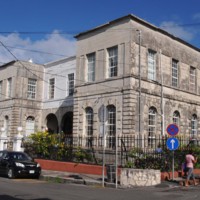
Museum of Antigua and Barbuda
Housed in the former courthouse of Antigua's capital, St John's, the Museum of Antigua and Barbuda opened in 1985. Managed by the Historical and Archaeological Society, it interprets the history of Antigua from the island's geological birth until its political independence in 1967. Collecting is central to the museum's ethos and it has developed a large collection of items relating to its local history through acquisitions and donations. It also has a digital records library with over 25,000 records available to browse.
The exhibits themselves trace the history of Antigua chronologically. The first gallery maps the geological development of the island using natural history specimen and artist interpretations alongside text panels. There are also displays that showcase the traditional crafts of the island, including basket weaving.
The second gallery then explores the arrival of the Europeans to the island and the development of the plantation economy fueled by the transatlantic slave trade. Here the displays examine what life was like on the plantations, using objects that highlight the brutal nature of enslavement, as well as archaeological samples that provide an insight into the everyday life of the enslaved. Some text panels provide information about instances of resistance, alongside images of supporting archival sources.
The final gallery explores how the island developed following the abolition and then the emancipation of the slave trade, two world wars and political independence. Here, objects are complemented with oral testimonies from local people.
The museum also has a gallery for temporary exhibitions focussing on different aspects of Antigua and Barbuda's local history. It also runs a programme of community events, and a series of education sessions for schools.
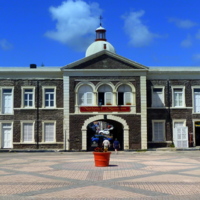
The National Museum of St Kitts
The National Museum of St Kitts is housed in the Old Treasury Building, built by the British colonial administration in 1894 and known as the 'gateway to Basseterre' due to its imposing size. The museum opened in 2002 and charts the history of St Kitts from its earliest, indigenous populations to its independence from colonial rule in 1983.
The museum has three permanent galleries which cover St Kitts' history in a chronological timeline making use of a small collection of artefacts, alongside images and text panels. The first gallery examines the indigenous populations of the island, alongside exhibits relating to natural history and ecology.
The second gallery explores the arrival of Europeans to the island and the development of slavery and the plantation economy. There are artefacts showcasing the brutal nature of enslavement, including an iron slave collar. It also explains the processes involved in the cultivation of sugar, as used on the plantations during the eighteenth and nineteenth centuries. It also provides a narrative of abolition and emancipation.
The final gallery examines the colonial governance of St Kitts post emancipation, through to independence from British rule in 1983.
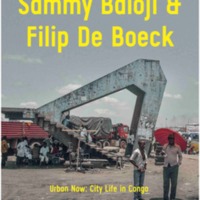
Urban Now: City Life in Congo, Various Venues (2016-2017)
This exhibition by photographer Sammy Baloji and anthropologist Filip De Boeck offers an exploration of different urban sites in Congo, through the media of photography and video. Focusing upon the “urban now”, a moment suspended between the broken dreams of a colonial past and the promises of neoliberal futures, the exhibition offers an artistic and ethnographic investigation of what living – and living together – might mean in Congo’s urban worlds.
As elsewhere on the African continent, Congo’s cities increasingly imagine new futures for themselves. Today, these new urban dreams often only manifest themselves in the form of billboards and advertisements for the city to come, inspired by Dubai and other recent hot spots from the Global South. Ironically, the city model they propose invariably gives rise to new geographies of exclusion that often take the form of gated communities and luxury satellite towns designed for a still somewhat hypothetical local upper middle class.
In sharp contrast with these neoliberal imaginings, the current infrastructure of Congo’s cities is of a rather different kind. The built colonial legacy has largely fallen into disrepair. Its functioning is punctuated by constant breakdown, and the city is replete with disconnected fragments, reminders and echoes of a former modernity that continues to exist in a shattered form. These failing material infrastructures greatly impact upon the quality of the city’s social life, and push it to the limit of what is livable. Yet Congo’s urban residents constantly engage in inventing new social spaces to bypass or overcome breakdown, exclusion, poverty and violence. Exploring these spaces, the exhibition captures a more inhabitable and inclusive urban world, where the possibilities of collective action and dreams of a shared future continue to be explored.
Curator: Devrim Bayar
The exhibition is organized in collaboration with and will travel to Galerias Municipais/EGEAC, Lisbon, and The Power Plant, Toronto.
With the support of the Research Fund of KU Leuven and Imane Farès Gallery, Paris.
In collaboration with Kunstenfestivaldesarts & Summer of Photography 2016.
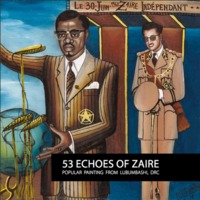
53 echoes of Zaire: Popular Painting from Lubumbashi Democratic Republic of Congo, Sulger-Buel Lovell Gallery, London (27 May – 30 June 2015)
Popular Painting is a genre traceable to the 1920s, which chronicles contemporary social and political realities in Congo (then Zaïre). This art movement remains very little known outside the continent. Scholars have dedicated their research activities to Popular Painting. They often knew the main actors of the movement in the early 1970s, and shared this knowledge by publishing articles, books and exhibition catalogues. “ During a brief period between the late sixties and the late seventies, popular genre painting bloomed in the urban and industrial Katanga region of the Democratic Republic of the Congo Artists, most of them self-educated, produced paintings (acrylics or oils on canvas reclaimed from flour sacking) for local use. Through a limited number of recurrent topics, they articulated a system of shared memories.